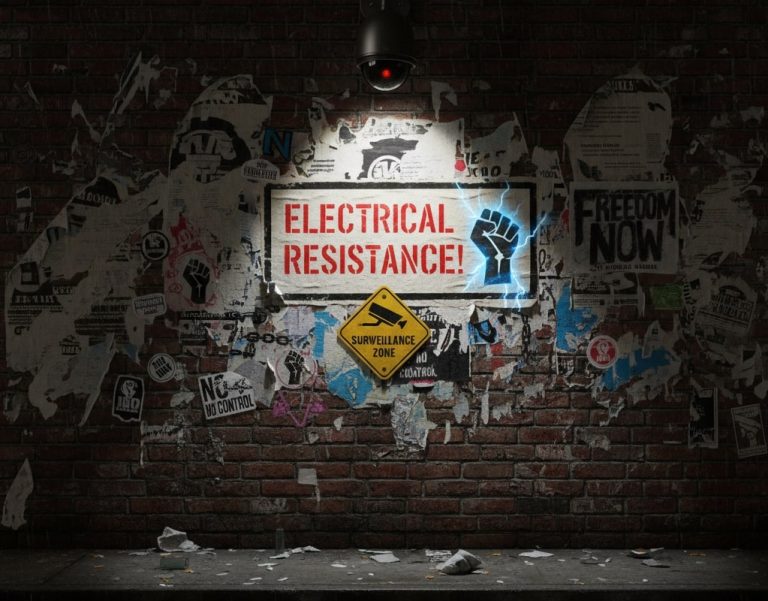Picture yourself as an overeager electron sitting at the edge of a metal wire, itching for some action. What could possibly kick-start your journey through this electrifying maze? A motivational speaker with a micro-megaphone? An electron-sized espresso? No—what you need is voltage!
Think of voltage as the persuasive friend who whispers, “Go on, take the leap; the other side of the wire is fantastic!” Voltage is the push that makes you, the electron, start your journey along the wire, powering up whatever device lies in wait for your electric touch.
This is the story of voltage, the unseen hero of our electrical world. Without it, you—as the eager little electron—would remain stuck at the edge of that wire indefinitely, never experiencing the thrills of powering up a lightbulb, bringing to life a smartphone, or igniting the engine of an electric car.
Welcome to 1000whats. Buckle up, because it’s going to be a positively charged ride about voltage, ensuring you’ll never look at your electrical gadgets the same way again.
What is voltage?
Got a syringe lying around? No? No worries—just fire up your imagination. Picture yourself holding one.
Now, fill that imaginary syringe with water.
Take a good look. Notice how nothing happens? The water just chills there, doing absolutely nothing. You could stare at it forever, and it would still just sit there like a bored cat.
Now—push the plunger.
Boom! Water squirts out the top. Magic? Not quite. It’s pressure. You applied a force, and suddenly, the water had somewhere to go. Push gently, you get a slow drip. Push hard, and you’ve got yourself a mini water cannon. The point? The push creates the flow.
Now, let’s get a little weird.
Imagine that syringe is filled with electrons instead of water. (Yes, I know you can’t do that in real life, just roll with me here.)
Push the plunger again. This time, instead of a splash, you get a stream of electrons zipping out. That flow of electrons? That’s electric current. And what caused it to move in the first place?
Voltage.

The great electron motivator
Without voltage, electrons are just lazy couch potatoes.
Voltage is the force—the push—that gets electrons moving. Without it, they won’t budge. But give them a nudge, and suddenly, you’ve got a current. The higher the voltage, the stronger the push, and the faster those little guys hustle down the wire.
No voltage – no current. Just a sad little wire doing nothing.
So next time you plug in your phone, remember: there’s an invisible hand giving electrons a good shove down the path. That hand is voltage. It’s not magic. It’s just good ol’ fashioned physics… with a little attitude.
The technical bit—still fun, promise
Now, if we want to sound clever at dinner parties, here’s the more precise definition:
Voltage is the amount of electric potential energy per unit of charge.
Think of it like this—each electron is holding a little energy backpack. Voltage is how full the backpack is. More volts = more energy to do useful work, like powering your phone or car.
We measure voltage in volts (V).
It’s basically the currency of electron motivation. The higher the voltage, the more eager those electrons are to move.
Voltage is the amount of electric potential energy per unit of charge.
This number—those volts—lets us predict how strongly the electrons will push forward, and how much electrical work a system can do.
The voltage formula: Small equation, big idea
Let’s get mathematical.
At its core, voltage tells us how much energy each little packet of charge gets when it moves. It’s the VIP treatment for electrons.
Physicists capture this with the formula:
V = ΔU / q
Where:
- V is voltage (in volts)
- ΔU is the change in electric potential energy (in joules)
- q is the electric charge (in coulombs)
Put simply, this equation whispers: “Voltage is just energy per charge.”
Why is it called voltage?
Blame it on a guy named Alessandro Volta.
Back in the 1700s, Volta stacked up some metal and cloth, added a splash of chemistry, and zap—the first battery was born. He basically invented the electric sandwich.
To honor his shocking success, scientists named the unit of electric push the volt. And when you talk about how much push you’ve got? That’s voltage.
Voltage = Volta’s legacy + pressure for electrons.
Also, engineers in the 1800s were desperate to explain electricity. So they said, “It’s like plumbing, but invisible!” Voltage became water pressure. Current became flow. Pipes turned into wires. People got it. Nobody got electrocuted (well, fewer people).
So yeah—voltage is just a fancy way to say, “Thanks, Volta, for making electrons go places.”
How does voltage create current?
If voltage is the push, then current is the movement. Together, they’re the dynamic duo of electricity—like salt and pepper, sneakers and laces, or coffee and mornings. You can’t really talk about one without the other.
The push-and-flow relationship
Let’s go back to our water analogy (because it’s oddly perfect).
Imagine a pump building up pressure—that’s voltage. Now, open a valve. Water flows—that’s current. No pressure – no water moves.
In the physics world, we call current “I”, and it measures how fast electric charge flows, in units called amperes (A). Voltage gives the push. Resistance (R) tries to slow the party down. And tying it all together is this beautifully simple Ohm’s famous law:
V = I × R
Where:
- V is voltage, the push.
- I is current, the flow.
- R is resistance, the obstacle.
Voltage pushes. Resistance resists. Current is what survives the drama.
Want the full story on Electric current?
I unpacked it on 1000whats → https://1000whats.com/electric-current/
Voltage in daily life
Voltage isn’t just hiding in physics labs or power plants—it’s woven into nearly every part of your daily routine. From your morning alarm clock to the late-night series binge, it’s there, quietly pushing electrons to keep your world buzzing.
Home
- Wall outlets: In the U.S., the standard is 120 volts; in most of Europe, it’s 230 volts. That’s the electrical “pressure” waiting behind your socket, ready to power everything from lamps to laptops.
- Batteries: The AA battery in your remote is 1.5 volts. Your car battery? A sturdy 12 volts. That little bump in voltage makes the difference between flipping TV channels and starting an engine.
Body
Did you know your nervous system runs on voltage too? Tiny voltage differences across nerve cell membranes—about 70 millivolts—allow neurons to fire signals. Every thought, reflex, and heartbeat depends on these miniature bursts of electric potential.
In a way, you’re walking around with your own built-in electrical grid.
Nature
Now let’s go full drama.
A thundercloud can build up hundreds of millions of volts. When it can’t take the tension anymore, it throws a tantrum—and lightning strikes. Voltage doesn’t get flashier than that. Literally.
Final thoughts
Voltage isn’t just a number on your toaster. It’s the invisible force making your entire plugged-in life possible. From lighting your room to jumpstarting a factory robot, voltage is the push that keeps the world buzzing.
It’s not just science—it’s the rhythm behind your series binges, coffee machines, and, yes, even your heartbeat.
Got your brain zapped into curiosity mode? Good.
Here are a few juicy questions to chew on:
- How does voltage play a role in renewable energy systems like solar and wind?
- What safety innovations are being developed to protect people from high-voltage risks?
- Could future technologies harness natural high-voltage phenomena, like lightning, as a practical energy source?
- What’s the coolest or scariest voltage you’ve experienced—sparks from a socket, a car battery, or a thunderstorm?
Drop your thoughts in the comments—I read them all, and they often light up new directions for future posts.
Until next time, stay curious! ⚡



